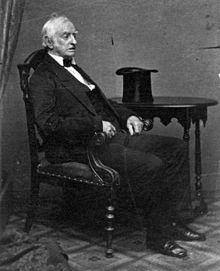
Catonsville is a census-designated place (CDP) in Baltimore County, Maryland. The population was 41,567 at the 2010 census. The community lies to the west of Baltimore along the city's border. Catonsville contains the majority of the University of Maryland, Baltimore County (UMBC), a major public research university with close to 14,000 students.

The University of Maryland, Baltimore County (UMBC) is a public research university in Catonsville, Maryland. It has a fall 2022 enrollment of 13,991 students, 61 undergraduate majors, over 92 graduate programs and the first university research park in Maryland. It is classified among "R1: Doctoral Universities – Very High Research Activity".
The University of Maryland School of Medicine, located in Baltimore City, Maryland, U.S., is the medical school of the University of Maryland, Baltimore and is affiliated with the University of Maryland Medical Center and Medical System. Established in 1807 as the College of Medicine of Maryland, it is the first public and the fifth oldest medical school in the United States. UMB SOM's campus includes Davidge Hall, which was built in 1812, and is the oldest building in continuous use for medical education in the Northern Hemisphere.

Richard Sprigg Steuart (1797–1876) was a Maryland physician and an early pioneer of the treatment of mental illness. In 1838 he inherited four contiguous farms, totalling approximately 1900 acres as well as 150 slaves.

George Hume Steuart (1790–1867) was a United States general who fought during the War of 1812, and later joined the Confederate States of America during the Civil War. His military career began in 1814 when, as a captain, he raised a company of Maryland volunteers, leading them at both the Battle of Bladensberg and the Battle of North Point, where he was wounded. After the war he rose to become major general and commander-in-chief of the First Light Division, Maryland Militia.

The Perry Point Mansion House and grist Mill is a national historic district at Perry Point, Cecil County, Maryland, United States. It is a 2+1⁄2-story, center-passage brick house covered with gray stucco. The 30 foot by 20 foot, stone grist mill is built into a river bank and is two to three stories high. Both structures were built about 1750. Since the end of World War I when the property was acquired by the Federal government, Perry Point has been used as a rehabilitation center, a supply depot, and a psychiatric hospital, the latter use surviving and expanding to the present.
The Walter P. Carter Center was a psychiatric hospital in Baltimore, Maryland.
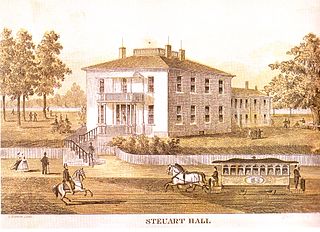
"Maryland Square", later known as "Steuart Hall", was a mansion owned by the Steuart family from 1795 to 1861, located on the western outskirts of Baltimore, Maryland, at the present-day junction of West Baltimore and Monroe streets. In the first year of the American Civil War, the property was confiscated by the United States Federal Government as its owner, George H. Steuart, a former United States Army officer, had resigned his commission to fight in the Confederate Army, in the Army of Northern Virginia as a brigadier general.

The Steuart family of Maryland was a prominent political family in the early History of Maryland. Of Scottish descent, the Steuarts have their origins in Perthshire, Scotland. The family grew wealthy in the early 18th century under the patronage of the Calvert family, proprietors of the colony of Maryland, but would see their wealth and status much reduced during the American Revolution, and the American Civil War.
Yale Heights is a neighborhood in the Southwest District of Baltimore, located between Beechfield (west) and Irvington (east). Most of its homes were built in 1955 as a development of two-bedroom, brick townhouses. Its population in 2008 was estimated at 2,916.
The Center for Urban Environmental Research and Education (CUERE) is located at the University of Maryland, Baltimore County (UMBC) in Catonsville, Maryland. The center's focus is primarily on the relationship between natural and socioeconomic processes that occur in urban environments.
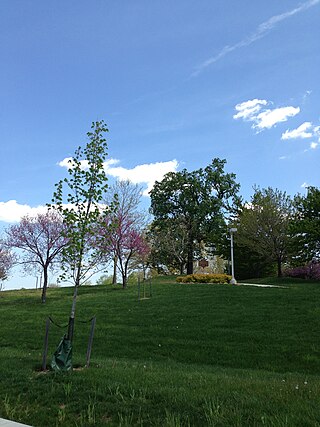
Giffen Hill is a highpoint on the campus of the University of Maryland, Baltimore County in Arbutus, Maryland, and is a historic site of the Manual Labor School for Indigent Boys. The hill is a gathering place near the UMBC Stadium, and will be adjacent to the future site of the UMBC Events Center, planned to open in 2017.
UMBC Transit is the official bus system of the University of Maryland, Baltimore County. Along with the Maryland Transit Administration (MTA), the UMBC community has public transit access to nearby areas such as Catonsville, Arbutus, Maryland, and Baltimore City.
The Short Line Railroad Trail is a 3.5-mile-long (5.6 km) trail in Western Baltimore County, Maryland. The trail segment begins approximately at the Charlestown Retirement Community off Maiden Choice Lane, south of the Baltimore National Cemetery, and ends at Frederick Road after traveling on several local streets in Downtown Catonsville. The trail connects the neighborhood of Paradise to Catonsville's Central Business District by using the abandoned right-of-way of the Baltimore and Potomac Railway. This portion of the B&P Railway was known as the "Short Line", spurring off the main line at Saint Agnes Station.
The Spring Grove Experiment is a series of lysergic acid diethylamide (LSD) studies performed from 1963 to 1976 on patients with psychotic illnesses at the Spring Grove Clinic in Catonsville, Maryland. These patients were sponsored by a federal agency called the National Institute of Mental Health to be part of the first study conducted on the effects of psychedelic drugs on people with schizophrenia. The Spring Grove Experiments were adapted to study the effect of LSD and psychotherapy on patients including alcoholics, heroin addicts, neurotics, and terminally-ill cancer patients. The research done was largely conducted by the members of the Research Unit of Spring Grove State Hospital. Significant contributors to the experiments included Walter Pahnke, Albert Kurland, Sanford Unger, Richard Yensen, Stanislav Grof, William Richards, Francesco Di Leo, and Oliver Lee McCabe. Later, Spring Grove was rebuilt into the Maryland Psychiatric Research Center where studies continued to be performed for the advancement of psychiatric research. This study on LSD is the largest study on psychedelic drugs to date.
Saleem Alam Shah was an Indian-American psychologist known for his work regarding mental health and the law. He has been credited with helping to establish forensic psychiatry as a specialty.
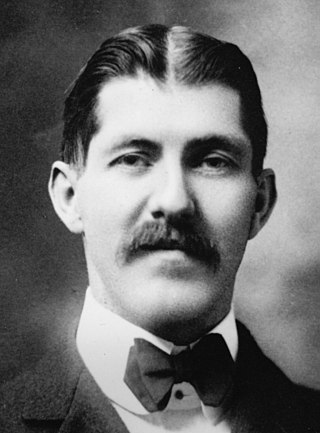
George Hume Steuart was a physician from Maryland who occupied a number of leading medical positions. He served at various times as superintendent of the Maryland University Hospital, chief medical director at the Rosewood Training School at Owings Mills, Maryland, and superintendent of the Lewis Gundry Sanitarium at Relay, Maryland. At the time of his death he was chairman of the Lancaster County Board of Supervisors, serving his third term.
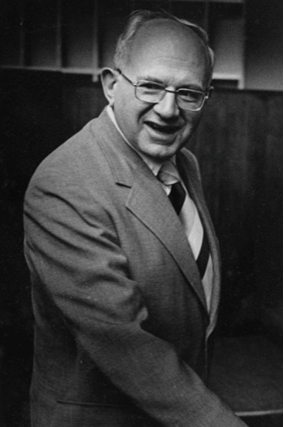
Albert Kurland was a psychiatrist and neuropsychopharmacologist at the Spring Grove State Hospital and the Maryland State Psychiatric Research Center. He was also affiliated with Johns Hopkins University as a research professor. He was a prolific researcher, conducting many studies on anti-psychotics, completing early research on the treatment of alcoholics using psychedelics, and making integral contributions to the research unit at the Spring Grove State Hospital.
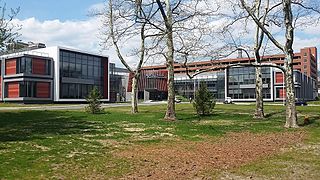
Zucker Hillside Hospital is a psychiatric facility that opened in 1926, relocated to its present address in 1941, and was renamed in 1999 to its present name.



